
Skip Setup Headaches and Start Your Project Fast - Download Free Boilerplates
ON THIS PAGE
ON THIS PAGE
Why Read This: Retail is evolving faster than ever. And AI in retail is rewriting its rulebook. In this blog, we unpack benefits and use cases of AI for the retail industry. Plus, we discuss challenges and a proven 5-step framework to bank on AI trends in retail. Dive in to see how forward-thinking retailers are using AI to redefine customer experience.
Over the last few years, the numbers around AI in retail have gone from speculative to striking. The global artificial intelligence in retail market was valued at about USD 14.24 billion in 2025. By 2030, it is expected to be worth about USD 31.18 billion.
But here’s what’s important: This isn’t big futuristic research happening behind closed doors.
The impact of AI on retail industry is visible in everyday interactions. Customers are now enjoying smoother experiences. Stores are using simple AI tools (think: recommendation engines, chatbots, demand forecasting!) to reduce waste, make shelves smarter, and sales smoother.
Surprisingly, the maximum impact has come from some of the simplest applications of AI in retail. Things like personalized suggestions, smarter inventory management, and dynamic promotions. AI in retail is not about exotic robotics or fully autonomous stores (those are coming too!) but most value today comes from the more accessible tools.
In this blog, we’ll cover all that and more. Dive in to see how you can ensure ROI of AI in retail, without overengineering.
When we talk about AI in retail, we’re referring to tech that helps retailers make smarter decisions. It also automates routine retail processes and delivers personalized experiences to customers.
This includes:
- Machine Learning
- Predictive Analytics
- Natural Language Processing
- Computer Vision
Other tools that analyze data to identify patterns, forecast trends, and guide actions
The key here is to understand that the impact of AI on retail industry is not happening behind the scenes in research labs. Instead, it’s actively reshaping how stores, online platforms, and supply chains operate. It is changing retail customer interactions.
To get started, an understanding of the AI in retail industry is important though.
What is AI in Retail?
AI in retail refers to the use of artificial intelligence in retail to automate, optimize, and enhance business operations and customer experiences. It includes AI retail solutions like:
- Personalized recommendations
- Predictive inventory
- Dynamic pricing
- Customer service automation
- Fraud detection
This helps retailers make data-driven decisions, improve efficiency, and deliver more engaging shopping experiences.
What are the Top Benefits of AI in Retail?
Retailers across sectors are using artificial intelligence in retail to achieve tangible results quickly. Key benefits include:
- Personalized shopping experiences that increase engagement and conversion
- Predictive inventory management that reduces waste and stockouts
- Dynamic pricing that optimizes revenue in real time
- Automated customer service that improves response times and satisfaction
- Fraud detection that protects revenue and builds customer trust
- Insights from Retail AI applications that support better business decisions
These benefits show how AI in retail business delivers measurable value across operations and customer interactions.
How Has AI in Retail Evolved Over the Years?
AI in retail has grown from simple automation to advanced systems today. It is shaping operations, customer experience, and strategy. The timeline below shows key phases of evolution and practical milestones:

Pre-2000s: Foundations of AI in Retail
- Early rule-based systems for inventory tracking and demand forecasting.
- Focused on improving efficiency and reducing manual errors in basic operations.
- Algorithms processed historical sales data with human supervision.
- Small retailers and early chains used software to monitor stock levels and reorder products.
2000–2010: Early Data-Driven Adoption
- Integration of machine learning models for customer segmentation and targeted marketing.
- Designed to improve sales by analyzing customer behavior.
- Algorithms examined purchase history, website activity, and demographics.
- Amazon introduced recommendation engines, an early practical AI in retail example.
2010–2020: Rapid Expansion and Consumer-Facing AI
- Widespread adoption of retail management software with innovative AI-powered features like personalized recommendations, dynamic pricing, predictive inventory, and chatbots.
- Enabled real-time responses to customer needs and operational optimization.
- Cloud computing and large-scale data processing allowed complex AI models.
- Retailers implemented predictive inventory management and AI-driven marketing campaigns.
2020 Onwards: AI Everywhere in Retail
- Use of omnichannel AI in retail sector. Solutions include smart shelves, cashier-less stores, voice assistants, and automated warehouses.
- Improved customer experience, reduced costs, and increased operational agility.
- AI models connected online and physical stores, integrating sales, inventory, and customer data.
- Retailers use recommendation engines, chatbots, and AI-powered warehouse robots to optimize engagement and supply chains.
Future Trends Beyond 2030
- Hyper-personalization, autonomous operations, predictive experiences, and sustainable AI solutions.
- Designed to drive efficiency, loyalty, and actionable insights.
- Generative AI, edge AI, AR/VR integration, and advanced analytics will guide decisions.
- Applications include predictive product design, micro-fulfillment centers, and AI-driven sustainability tracking.
What Are the Key Applications of AI in Retail?
AI in retail delivers tangible value when applied to real-world business operations. Here are five key areas where artificial intelligence in retail has made an impact.
Personalized Shopping Experiences
Businesses use AI retail solutions to recommend products based on individual customer behavior. Retailers do this by analyzing browsing patterns, purchase history, and contextual signals. This helps customers find products they want faster and increases conversion rates. Amazon's recommendation engine is a prime example of this. It drives sales by showing products that people are most likely to buy. But that's not all. With AI agent development, personalization is being offered in terms of price optimization and experience enhancement too.
Inventory Management
An inventory management system is key to retail success. When powered by the use of AI in retail sector, it helps retailers keep the right products in stock at the right time. Predictive models analyze historical sales, seasonal trends, and local events to forecast demand. This reduces stockouts and overstock, lowers waste, and improves cash flow. Walmart, for example, uses shelf-scanning robots to monitor inventory in real time. It also alerts staff when shelves need replenishment. This is one of the AI in retail examples that keeps both retailers and their customers happy. Retailers benefit from the operational efficiency improvements. Customers, on the other hand, always find what they need with ease.
Dynamic Pricing
Dynamic pricing is another common use case for AI for retail industry. Retailers use AI to adjust prices, response to demand, and suggest pricing. This helps maximize revenue and maintain competitiveness. Online retailers like Amazon adjust prices multiple times per day. Platforms like Uber also uses AI-driven surge pricing. It ensures that retailers are able to respond quickly to market conditions.
Customer Service Automation
Customer service automation is another one of the popular retail AI applications. AI-powered chatbots and VAs now handle routine queries and guide purchases. NLP enables these systems to understand customer questions and provide accurate, real-time responses. Sephora, for example, uses AI chatbots to help customers pick products. According to AI statistics, 95% of businesses that use AI in customer service report enhanced response quality. It also reduces response times and allows human agents to focus on complex cases.
Fraud Detection
Fraud detection is one of the lesser-known AI use cases in retail. Yet, AI is being used to monitor transactions for unusual patterns/suspicious activity. AI models analyze historical data to flag anomalies before they cause financial loss. Payment platforms and eCommerce companies use AI to secure transactions and protect customer trust. Target and Best Buy, for example, deploy AI-driven fraud monitoring. It prevents unauthorized purchases in-store and online, ensuring both security and confidence. Not just for businesses, but for customers too.
AI applications in these areas show that even simple uses of AI in retail business provide measurable benefits.
What are the Key Challenges in Implementing AI in Retail?
Implementing AI in retail comes with its benefits. But that doesn't mean the journey is always smooth. There are certain challenges or obstacles that retailers need to address.
The good part here is that systematically addressing these challenges is possible. And once that happens, you can still achieve strong results and measurable ROI of AI in retail.
Understanding the hurdles is, however, the 1st step to avoiding these common pitfalls:
Data Quality and Integration
High-quality, consistent data is essential for effective AI retail solutions. Many retailers struggle with fragmented systems, inconsistent formats, or missing data. Integrating and standardizing data across channels ensures accurate predictions and insights.
High Implementation Costs
The upfront investment for using AI for retail industry projects can be significant. Costs include software, hardware, cloud infrastructure, and talent. So, retailers need to evaluate the cost of AI adoption in retail against potential gains.
Focusing on high impact AI use cases can improve ROI of AI in retail while keeping expenses manageable.
Resistance to Change
Employees (and even management in some cases!) may hesitate to adopt AI in retail businesses due to fear of new workflows or job displacement. Change management programs, training, and demonstrating the practical value of retail AI applications, thus becomes crucial. It can reduce resistance and also ensure smooth adoption.
Privacy Concerns
Customer data drives a lot of AI implementations in Retail. However, handling this data responsibly is critical. Compliance with regulations and transparent data practices becomes important to maintain brand reputation. So, retailers must have robust security and privacy protocols in place.
Addressing these challenges does not require abandoning AI in retail solutions. With careful planning, clear priorities, and incremental adoption, retailers can overcome obstacles and unlock significant operational and customer-facing benefits.
How to Implement AI in Retail: A Step-by-Step Blueprint
Implementing AI in retail can feel complex. The challenges are plenty. But so are the benefits. With a structured approach and proper guidance around enterprise AI adoption, it is actionable. The following five-step blueprint guides retailers to plan, start, and successfully deploy AI retail solutions.
Important: At Radixweb, we have worked on multiple AI implementation projects, many of which were in the Retail domain. This blueprint is based on our experiences in those projects. By following these steps, we have successfully taken ideas and MVPs to the market as full-scale products. We hope following this blueprint brings similar outcomes for you.

Step 1. Assess Business Goals and Use Cases
The first step for any new technology implementation should be identifying where and why it should be used. It also stands when your goal is to implement AI in retail industry. Start by identifying where AI can create the most value even before you setup an AI consulting session with a vendor.
Once you know 'where' AI has to be implemented, define clear objectives. It could be anything like increasing sales, reducing stockouts, or improving customer engagement. If you come across AI projects, prioritize those with measurable outcomes and manageable scope. This will help demonstrate early results and build confidence in AI.
Step 2. Prepare and Integrate Data
High quality, consistent data is a key requirement for the success of AI projects. That's why it is important that you gather all data, including but not limited to:
- Historical sales
- Customer behavior
- Inventory records
- Operational metrics
Cleanse and standardize this data, and integrate systems across channels. A unified dataset ensures that AI in retail sector applications deliver accurate predictions and actionable insights. Without proper data preparation, even the best Retail AI applications will underperform.
Step 3. Choose the Right Tools and Technologies
Don’t directly jump into retail app development. Instead, look at different AI programming languages, tools, and platforms that align with your objectives. Consider scalability, integration, and ongoing support. Choosing the right tech and tools ensures that your solution is practical, sustainable, and capable of delivering measurable benefits. You may also want to look at similar AI in retail examples to see what tech choices are driving leaders forward.
Also, you may not even have to build an app/software from scratch. In many cases, app modernization can also help upgrade your retail business. The right vendor will be able to guide you in this case.
Step 4. Pilot, Test and Iterate
Start with small-scale pilots to validate your approach. Monitor model performance, measure outcomes, and gather feedback from users and staff. Adjust algorithms and workflows as needed. Pilot programs help reduce risk, improve adoption, and demonstrate the benefits of AI in retail before expanding to full-scale deployment.
Step 5. Deploy Fully and Continuously Improve
Once pilots succeed, roll out AI solutions for retail across relevant departments and channels. Train employees, update processes, and establish monitoring systems. Continuously track results and refine models using new data. This ensures that the use of AI in retail industry remains effective and delivers sustained value over time.
Following this step-by-step blueprint allows retailers to implement AI in retail business confidently, minimize risks, and maximize the impact of AI in retail sector on operations and customer experience.
Getting Started with AI in RetailAdopting AI in retail is a journey, and having the right partner makes it smoother and more effective. At Radixweb, we bring deep expertise in AI retail solutions and machine learning to help retailers implement practical, results-driven applications. Our experience spans personalized shopping experiences, predictive inventory management software development, dynamic pricing, customer service automation, and fraud detection.We focus on understanding your unique business goals before designing and deploying AI in retail business solutions. Every project is tailored to align with operational priorities and customer expectations. From data preparation and model selection to integration and continuous improvement, Radixweb ensures that the use of AI in retail industry drives measurable impact and supports sustainable growth.Our AI app development services combine technical expertise and real-world experience in the retail industry, which helps, retailers of all sizes adopt AI, efficiently and effectively. Schedule a no-cost consultation with our experts to see implementing AI in retail becomes actionable, practical, and aligned with your business strategy.
Frequently Asked Questions
How does AI improve customer experience in retail?
What types of AI models or technologies are used in retail?
How does AI in retail supply chain and inventory management reduce waste?
How to measure ROI of AI in retail?
How to use AI in retail?
Ready to brush up on something new? We've got more to read right this way.





